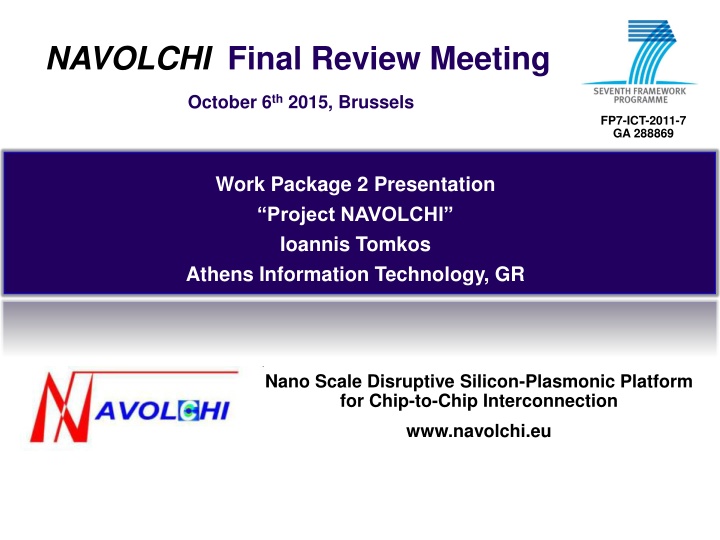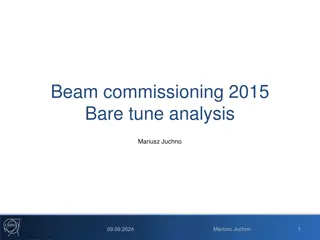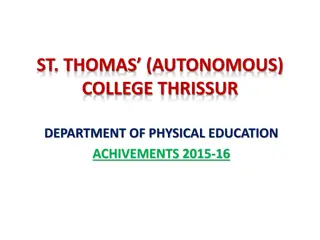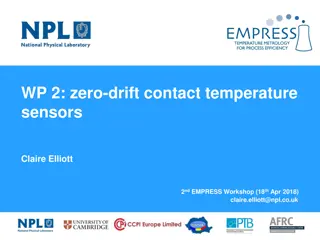
Nano Scale Silicon-Plasmonic Interconnect Technology Overview
"Explore the innovative Nano Scale Disruptive Silicon-Plasmonic Platform for Chip-to-Chip Interconnection presented in the NAVOLCHI project. Discover the potential, scope, objectives, and tasks involved in this cutting-edge technology aiming for high energy efficiency and cost-effectiveness in interconnects."
Download Presentation

Please find below an Image/Link to download the presentation.
The content on the website is provided AS IS for your information and personal use only. It may not be sold, licensed, or shared on other websites without obtaining consent from the author. If you encounter any issues during the download, it is possible that the publisher has removed the file from their server.
You are allowed to download the files provided on this website for personal or commercial use, subject to the condition that they are used lawfully. All files are the property of their respective owners.
The content on the website is provided AS IS for your information and personal use only. It may not be sold, licensed, or shared on other websites without obtaining consent from the author.
E N D
Presentation Transcript
NAVOLCHI Final Review Meeting October 6th2015, Brussels FP7-ICT-2011-7 GA 288869 Work Package 2 Presentation Project NAVOLCHI Ioannis Tomkos Athens Information Technology, GR Nano Scale Disruptive Silicon-Plasmonic Platform for Chip-to-Chip Interconnection www.navolchi.eu
Outline 1. WP2 Position in Project 2. Scope/Objectives 3. Tasks 4. Milestones and Deliverables 5. Summary Nano Scale Disruptive Silicon-Plasmonic Platform for Chip-to-Chip Interconnection 2
WP2 Position in Project Contributors: Nano Scale Disruptive Silicon-Plasmonic Platform for Chip-to-Chip Interconnection 3
Plasmonics vs. Photonics vs. Electronics Plasmonics can be as fast as photonics and as cost and effective as electronics! For an interconnect technology, the first most critical parameter is the energy efficiency (measured in pJ/bit or mWatt/Gbps) and the second the cost per bit ($/Gbit). A third metric, less important but still significant for the system design, is the bandwidth density (Gbps/inch or Gbps/mm2). For chip-scale interconnects, plasmonics offer the highest performance when considering all these parameters Nano Scale Disruptive Silicon-Plasmonic Platform for Chip-to-Chip Interconnection 4
Target energy and cost of interconnects Due to the high loss of plasmonics, they are only suitable for chip scale interconnects Nano Scale Disruptive Silicon-Plasmonic Platform for Chip-to-Chip Interconnection 5
Scope/Objectives of WP2 To demonstrate the feasibility of chip-scale plasmonic interconnects To derive the specs for the components of the plasmonic interconnect To estimate the energy efficiency of interconnects To compare plasmonic interconnects with photonic and electronic ones To present a roadmap for the evolution of interconnect technology Nano Scale Disruptive Silicon-Plasmonic Platform for Chip-to-Chip Interconnection 6
Tasks Nano Scale Disruptive Silicon-Plasmonic Platform for Chip-to-Chip Interconnection 7
Milestones Names of the Milestones Month Partner Definition of chip-to-chip interconnection system environment and specification Definition of plasmonic devices and material properties for chip-to-chip interconnection Development of a system and device simulation platform Definition of the interconnection level specification employing developed plasmonic devices Digital domain to plasmonic domain interface specification and VHDL modelling Plasmonic interconnect VHDL modelling Investigation of the cost and power consumption efficiency of the developed plasmonic devices MS1 3 AIT MS2 6 AIT MS3 18 AIT MS4 18 ST MS5 21 ST MS6 24 ST MS7 37 AIT Nano Scale Disruptive Silicon-Plasmonic Platform for Chip-to-Chip Interconnection 8
Deliverables Names of the Deliverables Definition of chip-to-chip interconnection system environment and specification Definition of plasmonic devices Investigation of chip-to-chip interconnection-level specifications employing new plasmonic devices Interface and plasmonic interconnect models and reports Techno-economical evaluation with respect to the cost efficiency and green aspects Report on new applications and their opportunities Month Partner D2.1 3 ST D2.2 12 AIT D2.3 24 AIT D2.4 24 ST D2.5 45 AIT D2.6 45 AIT Nano Scale Disruptive Silicon-Plasmonic Platform for Chip-to-Chip Interconnection 9
Task 2.2 Modeling of the integrated system 3 simulation models have been developed and the corresponding systems have been evaluated: Scenario 1: A directly modulated laser (DML) - based system in which the data are applied directly on the driving current of the metallo-dielectric laser source to produce NRZ OOK signals Scenario 2: A differential phase shift keying (DPSK) transmitter, utilizing the plasmonic MZM driven by the metallo dielectric laser source in continuous wave (CW) mode and with differential phase shift keying (DPSK) detection based on a passive delay line interferometer (DLI) at the receiver Scenario 3: An intensity modulation transmitter (NRZ OOK) utilizing the MZM and the laser source in CW mode, with direct detection at the receiver Nano Scale Disruptive Silicon-Plasmonic Platform for Chip-to-Chip Interconnection 10
Scenario 1: Directly modulated laser A directly modulated metallo-dielectric laser (DML) - based system Nano Scale Disruptive Silicon-Plasmonic Platform for Chip-to-Chip Interconnection 11
Scenario-1 results BER vs rec. power at various Rx LPF BWs BER vs rec. power at various responsivities Nano Scale Disruptive Silicon-Plasmonic Platform for Chip-to-Chip Interconnection 12
Scenario-2 Externally, phase modulated MZM (DPSK) via metallo-dielectric laser in CW (EML) - based system 2 cases examined: with or without plasmonic preamplifier prior to detector This scenario assumes a PIN detector and has a DI in front of it for decoding (having 6dB loss) Nano Scale Disruptive Silicon-Plasmonic Platform for Chip-to-Chip Interconnection 13
Scenario-3 Externally, amplitude modulated MZM (OOK) via metallo-dielectric laser in CW (EML) - based system 2 cases examined: with or without plasmonic preamplifier prior to detector Nano Scale Disruptive Silicon-Plasmonic Platform for Chip-to-Chip Interconnection 14
EML scenarios device characteristic tables Nano Scale Disruptive Silicon-Plasmonic Platform for Chip-to-Chip Interconnection 15
EML scenarios results: without amplifier BER performance at specified bitrate (7.2Gbps) is estimated for maximum overall losses that the system can handle, for range of values of various critical parameters: CW laser output powers (no booster amplifier between CW and MZM) MZM overall losses Detector responsivities (range covers both conventional Si/Ge and plasmonic detectors) Amplified input powers to MZM (booster amplifier is placed between CW and MZM ) Other system bitrates 1. 2. 3. 4. 5. For measuring BER performance versus interconnection distance at specified bitrate and other bitrates, data values of interconnection loss in dB/mm and typical ranges of chip to chip distances were assumed. Nano Scale Disruptive Silicon-Plasmonic Platform for Chip-to-Chip Interconnection 16
Scenario 2: EML DPSK without amplifier At const system bitrate:7.2Gbps CW laser power 10dBm and 0.4A/W Rx responsivity At const system bitrate:7.2Gbps CW laser power 10dBm Nano Scale Disruptive Silicon-Plasmonic Platform for Chip-to-Chip Interconnection 17
Scenario 3: EML OOK without amplifier At constant system bitrate:7.2Gbps for various responsivity At const system bitrate:7.2Gbps CW laser power 10dBm and 0.4A/W Rx responsivity Nano Scale Disruptive Silicon-Plasmonic Platform for Chip-to-Chip Interconnection 18
Conclusions from the T2.2 studies Directly modulated (DML) scenario shows poor BER performance for such low operating laser powers (40uW) Externally modulated (EML) scenario shows better BER performances than DML (at an extra cost ) Performance can be further improved by reducing MZM total losses, especially when system is to be operated at higher than default bit rate (7.2Gbps) In either case the performance can be greatly enhanced by placing a plasmonic amplifier prior to detector. However the technology to realize plasmonic amplifiers is still immature. Nano Scale Disruptive Silicon-Plasmonic Platform for Chip-to-Chip Interconnection 19
Task 2.4 Techno-economical study A techno-economical evaluation of chip interconnects with respect to their cost and power consumption has been performed A comparison among conventional electronic CMOS, photonic and the NAVOLCHI project interconnect approach was attempted, on the basis of energy efficiency and implementation issues The comparison was performed for each of the components comprising the interconnect system Both active (transmitters, receivers) and passive modules (waveguides, couplers) were evaluated in terms of their energy efficiency Nano Scale Disruptive Silicon-Plasmonic Platform for Chip-to-Chip Interconnection 20
Energy efficiency of photonic and electronic interconnects Source: ASCAC Subcommittee for the Top Ten Exascale Research Challenges, US Dept Of Energy report, Feb 2014 Nano Scale Disruptive Silicon-Plasmonic Platform for Chip-to-Chip Interconnection 21
Roadmap & energy efficiency comparison of different chip interconnect technologies Year Node techn. (nm) Energy efficiency in pJ/bit Optical technology roadmap Navolchi (hybrid) Navolchi (hybrid) IBM optical STmicro optical CMOS convent. (ITRS projected) 30-40 Optical 28 24 10-20 25 15 AOC VCSEL Backplane Si Backplane and 2013 2015 Cu/VCSEL for Backplane Ph for 22/20 ~5 5 4.4 11-8 2016/2017 Si interposer and Board Ph for 18 17/15 Cu/VCSEL and Si Ph. for Backplane 2018 2019/2020 ~1-2 ~1 1.7 4.5-3 Si Ph on chip 14-11 Cu/VCSEL and Si Ph. Board 2021-2024 for 10 9-5 ~0.5 ~0.05 1.3 0.8 Si Ph. Onto chip 2025 beyond Nano Scale Disruptive Silicon-Plasmonic Platform for Chip-to-Chip Interconnection 22
Photonic and Plasmonic DM Sources PHOTONIC SOURCES description Bit rate reference Energy consumption fJ/bit VCSEL VCSEL VSCEL VCSEL VCSEL SILICON NANOPHOTONIC SOURCES Photonic crystal nanocavity laser w/wo QD gain region InGaAsP/InP buried heterostructure photonic crystal (PhC) laser PhC laser LEAP (Lambda-Scale Embedded Active Region Photonic-Crystal) Photonic Crystal Nanocavity 25Gbps 34Gbps 40Gbps 38Gbps [14] [18] [19] [20] 77 140 158 203 NA [21] 13fJ/bit 20Gbps [22] 8.76fJ/bit 10Gbps [23] 4.4fJ/bit 20Gbps [24] 8.76fJ/bit Photonic Crystal Nanocavity with QD Crystal nanocavity LED PLASMONIC SOURCES description 10Ghz [25] 1fJ/bit 10Ghz [26] 0.25fJ/bit Bit rate reference Energy consumption fJ/bit - a tungsten photonics cavity sandwiched between layers of selenium(gain medium) Semiconductor nanolasers with metallo-dielectric cavities NA [27] <10Gbps [28] 5fJ/bit Nano Scale Disruptive Silicon-Plasmonic Platform for Chip-to-Chip Interconnection 23
Photonic and Plasmonic Modulators PHOTONIC MODULATORS description Bit rate reference Energy consumption fJ/bit 0.75fJ/bit Ge quantum well waveguide-integrated modulator On silicon No resonator asymmetric F-P EAM quantum-confined Stark (QCSE AFPM) effect in Ge/GeSi quantum wells silicon microdisk Ge QCSE Ge Si EAM FKE Ge EAM FKE ring resonator modulator microring based resonator EOM nano-photonic MZ silicon microring modulator 7Gbps [30] NA [31] 10 fJ/bit 12.5Gbps NA >100 GHz 30GHz 32Gbps 10Gbps 10Gbps 1Gbps [32] [33] [34] [35] [36] [37] [38] [39] 3fJ/bit 6fJ/bit 25fJ/bit 100fJ/bit 82 fJ/bit 50fJ/bit 5pJ/bit 7.9fJ/bit PLASMONIC MODULATORS description Bit rate reference Energy consumption fJ/bit 18fJ/bit EO phase modulator Pockels in nonlinear polymer Plasmonic MZ MDM compact plasmonic modulator based on resonance in a nano slit-groove ITO-EOM in a plasmonic silicon-on-insulator (SOI) hybrid design Layered metal/chalcogenide waveguide PM 40Gbps [40] 72Gbps 40Gbps [41] [42] 20fJ/bit 1fJ/bit >50Gbps [43] 2-4.3fJ/bit >50Gbps [44] 0.003fJ/bit Array of Ag nanoparticles in EOP matrix PM >50Gbps [45] 0.01fJ/bit Slotline Si/EOP/Si PM >50Gbps >50Gbps [46] [47] 16fJ/bit 0.16fJ/bit Hybrid Plasmonic with SOI Graphene-Based Electro-Optic Modulators Nano Scale Disruptive Silicon-Plasmonic Platform for Chip-to-Chip Interconnection 24
Photonic and Plasmonic detectors PHOTONIC DETECTORS description Bit rate reference Energy consumption fJ/bit 33fJ/bit Micrometer scale Ge PD Ge photodetectors on silicon Ge PD Ge/Si APD PLASMONIC DETECTORS description 3Gbps [48] 40Gbps [49] 2.4fJ 25Gbps 10Gbps [50] [51] 5.6fJ/bit 0.18fJ/bit Bit rate reference Energy consumption fJ/bit 5aJ Nanometallic Dipole Antenna Enhanced Photodetector integrated plasmonic Ge photodetector NA [52] 50GHz [53] 70aJ/bit Nano Scale Disruptive Silicon-Plasmonic Platform for Chip-to-Chip Interconnection 25
Photonic and plasmonic waveguides and couplers Si PHOTONIC WAVEGUIDES attenuation 0.5dB/cm 1.4-4.5dB/cm PLASMONIC WAVEGUIDES attenuation 0.28-0.3dB/ m reference [51] [38] material silicon core on insulator (SOI) silicon core on insulator (SOI) reference [55] [56] [56] material plasmonic(M-I-si.I-M) Slot-line Hybrid plasmonic 3.0733 dB/ m 0.01-0.22dB/ m COUPLERS Coupling loss < 1dB 1.1dB reference [57] [58] Description Fiber to Si waveguide photonic to plasmonic mode conversion coupling losses per Si-to-DLSPP interface 2.5 dB [59] Nano Scale Disruptive Silicon-Plasmonic Platform for Chip-to-Chip Interconnection 26
Chip interconnect energy consumption at device level 120 100 80 60 VCSEL Si NanoPhotonics ENERGY fJ/bit Plasmonics 40 20 0 DML Laser Modulator Detector Total Interconnect Average energy efficiency, for each interconnect device module separately (laser sources, modulators and detectors) is presented Nano Scale Disruptive Silicon-Plasmonic Platform for Chip-to-Chip Interconnection 27
D2.6 Report on new applications and their opportunities The NAVOLCHI laser can be used also in other applications Sensors: It has been demonstrated that nanoscale cavity sources show high performance in certain sensing applications due to the large surface-to-volume ratio, which make them highly sensitive to the environment. By monitoring the emission intensity, a nanolight source can be used to sense the enviromental conditions. For example, recently an optically pumped plasmon nanocavity laser source achieved a sub-part- per-billion explosive molecule detection. Biomedical: it has been suggested that nano- and micro-scale lasers based on fluorescent labelled DNA as gain medium may find applications in optical DNA sequencing. Nano Scale Disruptive Silicon-Plasmonic Platform for Chip-to-Chip Interconnection 28
NAVOLCHI plasmonic amplifier: Wavelength conversion Use of PbS based devices for wavelength conversion We showed that the interplay between intraband and bandgap absorption in colloidal quantum dots (QDs) leads to a very strong and ultrafast modulation of the light absorption after photoexcitation in which slow components linked to exciton recombination are eliminated This approach enables all- optical wavelength conversion at rates matching state-of-the-art convertors in speed, yet with significantly cheaper materials Nano Scale Disruptive Silicon-Plasmonic Platform for Chip-to-Chip Interconnection 29
Summary The feasibility of chip-scale plasmonic interconnects was demonstrated. Plasmonic interconnects were compared with photonic and electronic ones The energy efficiency of chip-scale interconnect technologies was estimated and a relevant roadmap was presented Nano Scale Disruptive Silicon-Plasmonic Platform for Chip-to-Chip Interconnection 30
Summary The comparison showed that, among conventional electronic, photonic and plasmonic technologies, the plasmonic interconnects show the highest bandwidth density and the highest energy efficiency and are perfectly suitable for chip-scale interconnects It is worth pointing out that the plasmonic modulators can reach energies down at sub-fj levels, while plasmonic detectors can reach energies down to attojoule levels. Individual critical components, such as the modulators, laser sources and photodetectors, can be also used in other applications beyond chip-scale interconnects Nano Scale Disruptive Silicon-Plasmonic Platform for Chip-to-Chip Interconnection 31












